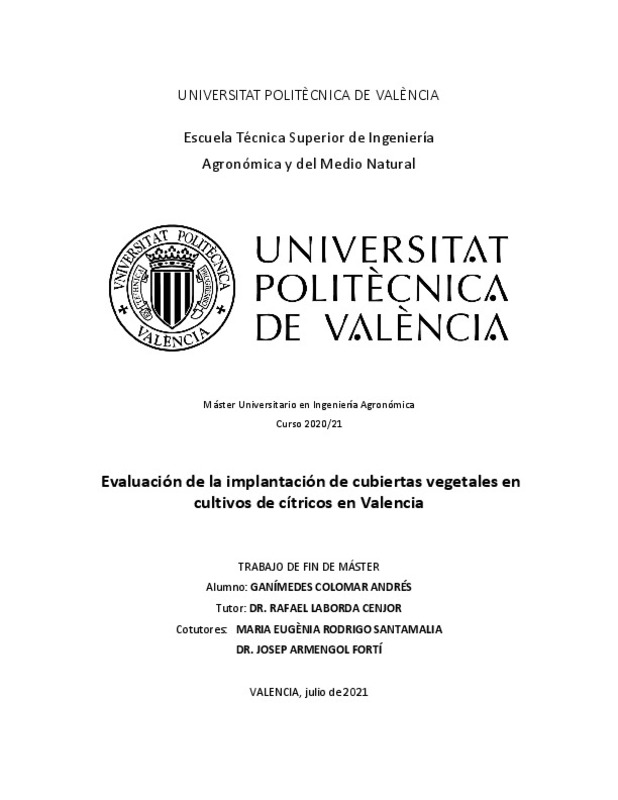JavaScript is disabled for your browser. Some features of this site may not work without it.
Buscar en RiuNet
Listar
Mi cuenta
Estadísticas
Ayuda RiuNet
Admin. UPV
Evaluación de la implantación de cubiertas vegetales en cultivos de cítricos en Valencia
Mostrar el registro sencillo del ítem
Ficheros en el ítem
| dc.contributor.advisor | Laborda Cenjor, Rafael
|
es_ES |
| dc.contributor.author | Colomar Andrés, Ganímedes
|
es_ES |
| dc.coverage.spatial | east=-0.3762881; north=39.4699075; name=46002 Valencia, Espanya | es_ES |
| dc.date.accessioned | 2021-10-08T13:31:27Z | |
| dc.date.available | 2021-10-08T13:31:27Z | |
| dc.date.created | 2021-09-22 | |
| dc.date.issued | 2021-10-08 | es_ES |
| dc.identifier.uri | http://hdl.handle.net/10251/174266 | |
| dc.description.abstract | [ES] Dos de los grandes enemigos de los cultivos de cítricos, al igual que de la agricultura en general, son las plagas y la vegetación adventicia. Ambos suponen un gran coste para los agricultores, ya sea por los daños que causan a la calidad del producto final o a la productividad del cultivo, o por el coste que supone afrontarlos para evitar estos daños. No solo eso, sino que los tratamientos convencionales, mediante productos químicos generalmente tóxicos y perjudiciales para el medio ambiente, implican un coste social y ambiental añadido. La prevención mediante el restablecimiento de la diversidad vegetal y animal es una alternativa sostenible y respetuosa con el medio ambiente, y las cubiertas vegetales, un método de manejo del suelo utilizado desde tiempos pasados y que está recobrando popularidad, tienen un gran potencial en este sentido. En este estudio se ha analizado la implantación de dos cubiertas vegetales sembradas distintas, en cultivos de mandarinos de fincas comerciales en la provincia de Valencia en el año 2020. Se ha estudiado la cobertura y la distribución de las especies que componían estas dos mezclas, así como la abundancia de artrópodos presentes en estas cubiertas. Las cubiertas tuvieron en general una implantación bastante buena, con una cobertura del suelo bastante alta, y el crecimiento de especies espontáneas fue limitado. Algunas de las especies sembradas, sin embargo, nunca llegaron a germinar. La presencia de artrópodos fue también bastante elevada, con una alta proporción de parasitoides de la superfamilia Chalcidoidea y de la familia Braconidae, siendo estos dos grupos en conjunto más abundantes incluso que el total de fitófagos identificados. Los fitófagos más abundantes fueron los Cicadellidae con mucha diferencia, seguidos de Thysanoptera y Aphididae. | es_ES |
| dc.description.abstract | [EN] Two of the big enemies of citrus crops, as well as of agriculture in general, are pests and weeds. Both entail a great cost for growers, either because of the damage they cause to the quality of the final product or to the crop¿s productivity, or because of the cost that it means to deal with them to prevent that damage. Furthermore, conventional treatments usually use chemical products which are generally toxic and harmful for the environment, implying added social and environmental costs. Prevention by restoring plant and animal diversity is an environmentally friendly and sustainable alternative, and cover crops, a soil management method used since past times and which is recovering popularity, have a great potential in this matter. This study analyzed the establishment of two sowed cover crops, in mandarin trees in commercial orchards in the province of Valencia, during 2020. The canopy and distribution of the species of both blends were studied, as well as the arthropods present in them. These cover crops had in general a quite good implantation, with a large canopy percentage, and the weed growth was limited. Some of the sowed species, however, never germinated. The presence of arthropods was also quite high, with a great proportion of parasitoids of the superfamily Chalcidoidea and the family Braconidae, being these two groups together more abundant than the total number of identified phytophagous. The most abundant phytophagous insects were Cicadellidae, by far, followed by Thysanoptera and Aphididae. | es_ES |
| dc.format.extent | 36 | es_ES |
| dc.language | Español | es_ES |
| dc.publisher | Universitat Politècnica de València | es_ES |
| dc.rights | Reconocimiento - No comercial - Sin obra derivada (by-nc-nd) | es_ES |
| dc.subject | Cubiertas vegetales | es_ES |
| dc.subject | Plantas secundarias | es_ES |
| dc.subject | Control biológico | es_ES |
| dc.subject | Cítricos | es_ES |
| dc.subject | Agricultura sostenible | es_ES |
| dc.subject | Cover crops | es_ES |
| dc.subject | Secondary plants | es_ES |
| dc.subject | Biological control | es_ES |
| dc.subject | Citrus | es_ES |
| dc.subject | Sustainable agriculture | es_ES |
| dc.subject.classification | PRODUCCION VEGETAL | es_ES |
| dc.subject.other | Máster Universitario en Ingeniería Agronómica-Master Universitari en Enginyeria Agronòmica | es_ES |
| dc.title | Evaluación de la implantación de cubiertas vegetales en cultivos de cítricos en Valencia | es_ES |
| dc.type | Tesis de máster | es_ES |
| dc.rights.accessRights | Abierto | es_ES |
| dc.contributor.affiliation | Universitat Politècnica de València. Departamento de Ecosistemas Agroforestales - Departament d'Ecosistemes Agroforestals | es_ES |
| dc.contributor.affiliation | Universitat Politècnica de València. Escuela Técnica Superior de Ingeniería Agronómica y del Medio Natural - Escola Tècnica Superior d'Enginyeria Agronòmica i del Medi Natural | es_ES |
| dc.description.bibliographicCitation | Colomar Andrés, G. (2021). Evaluación de la implantación de cubiertas vegetales en cultivos de cítricos en Valencia. Universitat Politècnica de València. http://hdl.handle.net/10251/174266 | es_ES |
| dc.description.accrualMethod | TFGM | es_ES |
| dc.relation.pasarela | TFGM\140985 | es_ES |
Este ítem aparece en la(s) siguiente(s) colección(ones)
-
ETSIAMN - Trabajos académicos [3541]
Escuela Técnica Superior de Ingeniería Agronómica y del Medio Natural






